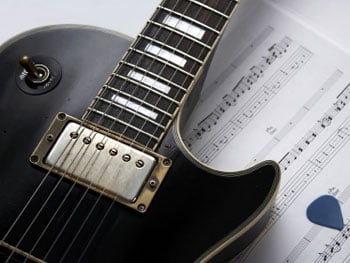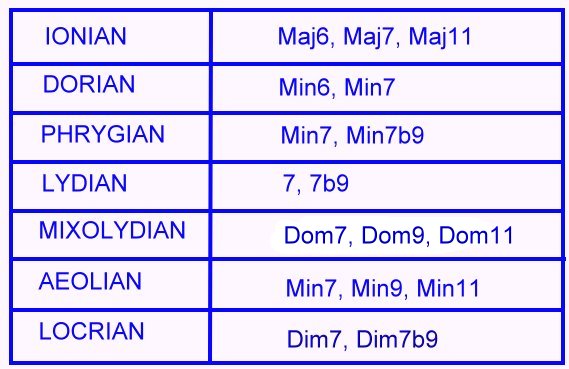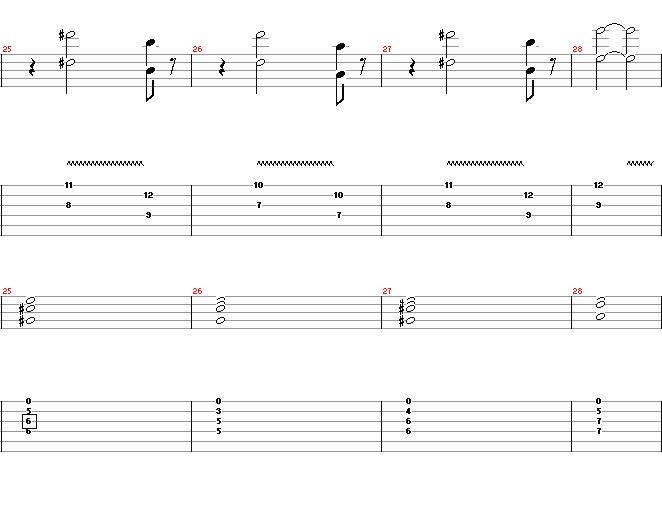Pitch axis theory
| (8 intermediate revisions not shown.) | |||
| Line 1: | Line 1: | ||
| + | [[Category:Theory]] | ||
| + | |||
[[Image:Default.jpg|thumb|350px|right|GMC Wiki]] | [[Image:Default.jpg|thumb|350px|right|GMC Wiki]] | ||
| - | Pitch | + | "Pitch Axis Theory" is a compositional technique that [[Joe Satriani]] has used in a number of his songs, along with other guitarists such as [[John Petrucci]], [[Steve Vai]], [[Marty Friedman]], [[Michael Angelo Batio]] and [[Guthrie Govan]]. |
| + | |||
| + | |||
| + | It is a musical technique used in constructing chord progressions. The tonic, or root, is used as the base note, and melodic scales are chosen according to the chords that lie beneath them. | ||
| - | "Pitch Axis Theory" is a compositional technique that Joe Satriani has uses in a number of his songs, along with other guitarists such as John Petrucci, Steve Vai, Marty Friedman, Michael Angelo Batio and Guthrie Govan. | ||
| Line 9: | Line 13: | ||
== Concept == | == Concept == | ||
| - | The seven modes are all connected to each other by diatonic shifts: C Ionian (C-D-E-F-G-A-B-C) is also D Dorian (D-E-F-G-A-B-C-D), E Phrygian (E-F-G-A-B-C-D-E) and so on, until you return to the original C Ionian Mode. | + | The seven [[modes]] are all connected to each other by diatonic shifts: C Ionian (C-D-E-F-G-A-B-C) is also D Dorian (D-E-F-G-A-B-C-D), E Phrygian (E-F-G-A-B-C-D-E) and so on, until you return to the original C Ionian Mode. |
Pitch axis theory suggests that for each mode, there is are chords that accompany it. When these certain chords occur, it implies a change between modes. | Pitch axis theory suggests that for each mode, there is are chords that accompany it. When these certain chords occur, it implies a change between modes. | ||
| Line 24: | Line 28: | ||
Here are some songs which use pitch axis theory, and how pitch axis theory works in them. | Here are some songs which use pitch axis theory, and how pitch axis theory works in them. | ||
| - | === Not Of This Earth - Joe Satriani === | + | === Not Of This Earth - [[Joe Satriani]] === |
| - | This picture is the chord sequence and first melody of Joe Satriani's song "Not Of This Earth". | + | This picture is the chord sequence and first melody of [[Joe Satriani]]'s song "Not Of This Earth". |
[[Image:Not_of_this_earth.jpg]] | [[Image:Not_of_this_earth.jpg]] | ||
| Line 32: | Line 36: | ||
All the chords are based around the root note of E. This is the whole point of pitch axis theory, to keep the same tonic center whilst changing the mode. | All the chords are based around the root note of E. This is the whole point of pitch axis theory, to keep the same tonic center whilst changing the mode. | ||
| - | The first chord has root note '''E''' and a major third ('''G#''') so it implies a major mode. The | + | The first chord has root note '''E''' and a major third ('''G#''') so it implies a major mode. The mode which fits in with this, because of the '''C#''' isn't the Lydian, but a Lydian is played for the first bar of the four bar sequence, even though it technically shouldn't. |
| + | |||
| + | The second chord has the notes '''E, G, C, D'''. The '''G''' implies a minor mode, and as it contains the 7th, the aeolian mode is played in this bar. | ||
| + | |||
| + | The third chord has the notes '''E, G#, C#, D#'''. The '''G#''' implies a major mode and the D# implies the Lydian to be played again. | ||
| + | |||
| + | The final chord has the notes '''E, A, D'''. This is a Dominant 7th chord and implies the Mixolydian mode. | ||
| + | |||
| + | This 4 bar pattern of chords and Lydian - Aeolian - Lydian - Mixolydian continues throughout the entire song. | ||
| + | |||
| + | ==== The Chords ==== | ||
| - | + | As you can see the chords are not always simply the chords in the table. They use other notes to make them more interesting but still imply the same mode. Also you do not have to strictly stick to the table, because as Joe Satriani has said, "As long as you keep the tonal center the same, then you're doing the pitch axis trick". | |
| - | Duis aute irure dolor in reprehenderit in voluptate velit esse cillum dolore eu fugiat nulla pariatur. Excepteur sint occaecat cupidatat non proident, sunt in culpa qui officia deserunt mollit anim id est laborum. | ||
| + | == Using Pitch Axis Theory == | ||
| - | + | A good way to start using pitch axis theory is to just have plain, neutral power chords in the backing, and experiment to find out what modal transitions are effective. You don't have to change mode every bar either, Satriani's Always With Me, Always With You has a long stretch in B Major, then a long stretch in B minor. This is still pitch axis theory. You also do not have to continue using pitch axis theory for a whole song. | |
| - | + | Once you have decided on modal transitions you can set down chords, using the table at the top if the page and your creativity. Once chords have been set you can start writing, improvising or whatever you want to do, using pitch axis theory. | |
| + | === Songs Containing Pitch Axis Theory === | ||
| - | + | Lie - [[Dream Theater]] <br> | |
| + | Satch Boogie - [[Joe Satriani]] <br> | ||
| + | Always With Me, Always With You - [[Joe Satriani]] <br> | ||
| + | Not of This Earth - [[Joe Satriani]] <br> | ||
| + | With Jupiter In Mind - [[Joe Satriani]] | ||
| - | + | Please expand this list with any songs you know containing use of pitch axis theory. | |
| + | === Artists Who use Pitch Axis Theory === | ||
| + | [[John Petrucci]] (Dream Theater) <br> | ||
| + | [[Joe Satriani]] <br> | ||
| + | [[Marty Friedman]] <br> | ||
| + | [[Steve Vai]] <br> | ||
| + | [[Michael Angelo Batio]] <br> | ||
| + | [[Guthrie Govan]] | ||
| - | == Related GMC Lessons == | ||
| - | (this is a speical headline that is optional) | ||
| - | + | Please expand this list with any artists you know who use pitch axis theory. | |
| - | [http://www.guitarmasterclass.netrhythm-guitar/blues-get-that-shuffle2/ Blue Shuffle 2 again] | ||
== See also == | == See also == | ||
| - | (this is a speical headline that is optional) | ||
| - | [[Main_Page|Link To Other Article I]] | ||
| - | [[ | + | [[Modes|https://www.guitarmasterclass.net/wiki/index.php/Modes]] |
| - | [[ | + | [[Joe Satriani|https://www.guitarmasterclass.net/wiki/index.php/Joe_Satriani]] |
Current revision
"Pitch Axis Theory" is a compositional technique that Joe Satriani has used in a number of his songs, along with other guitarists such as John Petrucci, Steve Vai, Marty Friedman, Michael Angelo Batio and Guthrie Govan.
It is a musical technique used in constructing chord progressions. The tonic, or root, is used as the base note, and melodic scales are chosen according to the chords that lie beneath them.
Contents |
Concept
The seven modes are all connected to each other by diatonic shifts: C Ionian (C-D-E-F-G-A-B-C) is also D Dorian (D-E-F-G-A-B-C-D), E Phrygian (E-F-G-A-B-C-D-E) and so on, until you return to the original C Ionian Mode.
Pitch axis theory suggests that for each mode, there is are chords that accompany it. When these certain chords occur, it implies a change between modes.
The table shows this link between chords and modes.
Examples
Here are some songs which use pitch axis theory, and how pitch axis theory works in them.
Not Of This Earth - Joe Satriani
This picture is the chord sequence and first melody of Joe Satriani's song "Not Of This Earth".
All the chords are based around the root note of E. This is the whole point of pitch axis theory, to keep the same tonic center whilst changing the mode.
The first chord has root note E and a major third (G#) so it implies a major mode. The mode which fits in with this, because of the C# isn't the Lydian, but a Lydian is played for the first bar of the four bar sequence, even though it technically shouldn't.
The second chord has the notes E, G, C, D. The G implies a minor mode, and as it contains the 7th, the aeolian mode is played in this bar.
The third chord has the notes E, G#, C#, D#. The G# implies a major mode and the D# implies the Lydian to be played again.
The final chord has the notes E, A, D. This is a Dominant 7th chord and implies the Mixolydian mode.
This 4 bar pattern of chords and Lydian - Aeolian - Lydian - Mixolydian continues throughout the entire song.
The Chords
As you can see the chords are not always simply the chords in the table. They use other notes to make them more interesting but still imply the same mode. Also you do not have to strictly stick to the table, because as Joe Satriani has said, "As long as you keep the tonal center the same, then you're doing the pitch axis trick".
Using Pitch Axis Theory
A good way to start using pitch axis theory is to just have plain, neutral power chords in the backing, and experiment to find out what modal transitions are effective. You don't have to change mode every bar either, Satriani's Always With Me, Always With You has a long stretch in B Major, then a long stretch in B minor. This is still pitch axis theory. You also do not have to continue using pitch axis theory for a whole song.
Once you have decided on modal transitions you can set down chords, using the table at the top if the page and your creativity. Once chords have been set you can start writing, improvising or whatever you want to do, using pitch axis theory.
Songs Containing Pitch Axis Theory
Lie - Dream Theater
Satch Boogie - Joe Satriani
Always With Me, Always With You - Joe Satriani
Not of This Earth - Joe Satriani
With Jupiter In Mind - Joe Satriani
Please expand this list with any songs you know containing use of pitch axis theory.
Artists Who use Pitch Axis Theory
John Petrucci (Dream Theater)
Joe Satriani
Marty Friedman
Steve Vai
Michael Angelo Batio
Guthrie Govan
Please expand this list with any artists you know who use pitch axis theory.
See also
https://www.guitarmasterclass.net/wiki/index.php/Modes
https://www.guitarmasterclass.net/wiki/index.php/Joe_Satriani








